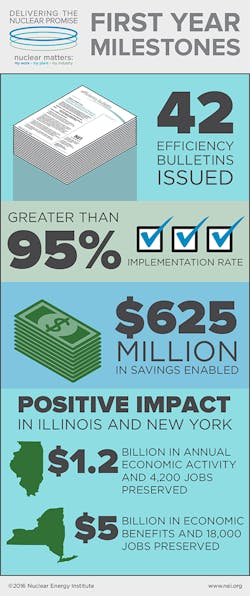Nuclear Industry Efficiency Program Makes Remarkable Gains in First Year
One year into its "Delivering the Nuclear Promise" initiative, the U.S. nuclear energy industry is making good on its ambitious effort to become more efficient and see nuclear power plants better valued financially as part of America’s critical infrastructure, according to a release from the NEI.
On the cost side, the industry identified more than $600 million in projected savings enabled to date across the industry in 2016. On the value side, the industry and its business, labor and environmental allies preserved at-risk facilities in Illinois and New York by persuading state leaders that their electric infrastructure and their economic and environmental goals are better served by the power stations’ continued operation. Both states have enacted policies that provide financial support—on a sliding scale—for nuclear energy facilities based on their value to the state.
The industrywide, Delivering the Nuclear Promise (DNP) effort was launched in December 2015 to identify efficiency measures and best practices that can be implemented throughout the industry.
“To thrive we must evolve. Effecting an overall change in mindsets and culture is a huge undertaking but absolutely indispensable to the survival and success of our industry,” said Maria Korsnick, the Nuclear Energy Institute’s chief operating officer. “We value the importance of safety and reliability and, while we maintain the high levels we have achieved, we also can focus on improving efficiency. We’ve made some terrific gains this first year.”
Over the past year, working collaboratively with the Electric Power Research Institute and the Institute of Nuclear Power Operations, NEI issued 42 efficiency bulletins in a variety of areas. Examples include:
- aligning standards for radiation worker training at all U.S. nuclear power plant sites
- standardizing training to access nuclear power plants and extending the renewal time
- reducing the amount of paperwork associated with routine preventive maintenance at nuclear plants
- saving resources by reducing or eliminating low-value preventative maintenance tasks, which are not critical to plant safety.
“Improving efficiency also improves safety and reliability, making an already safe technology better as we look to reduce electric generating costs and keep our reactors operating in a tough business climate,” said William Levis, PSEG Power president and chief operating officer and executive sponsor of the DNP steering committee.
Nuclear energy facilities operating in 30 states supply electricity to one of every five U.S. homes and businesses. Over the past four years, however, six reactors have closed prematurely, largely due to financial challenges, and another 10 to 15 are at risk of premature retirement. In several instances, the principal challenge is that attributes like on-site fuel supplies, reliability, fuel and technology diversity, and their emission-free nature aren’t valued in electric markets.
“Driving efficiency at nuclear power plants is critical for the survival of our industry, but that alone will not get us where we have to go,” Levis said. “Efficiency must go hand in hand with policymakers at the state and federal level acting to ensure existing nuclear power plants are correctly valued for the reliability, fuel diversity and environmental attributes they provide. More must be done across the country.”
Levis cited as evidence the actions of the New York Public Service Commission to keep the upstate plants operating and last week’s enactment of the Future Energy Jobs Bill in Illinois.

